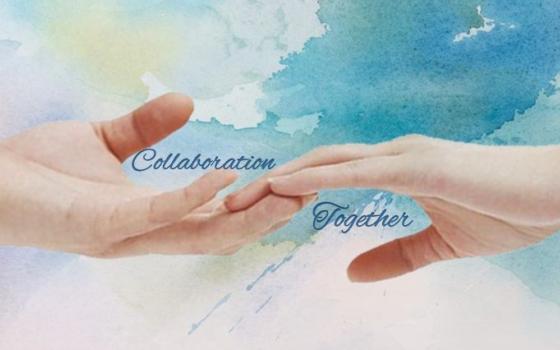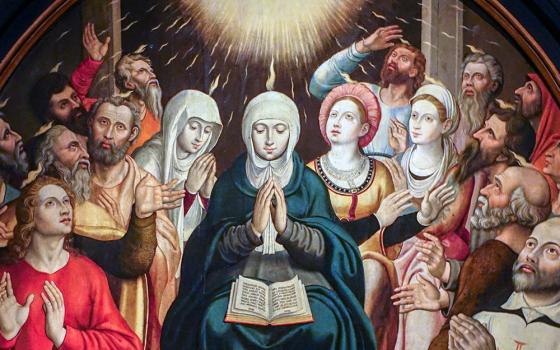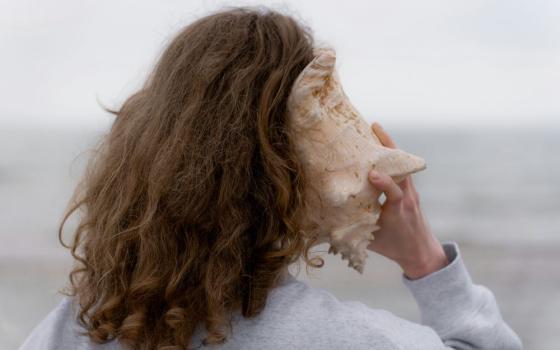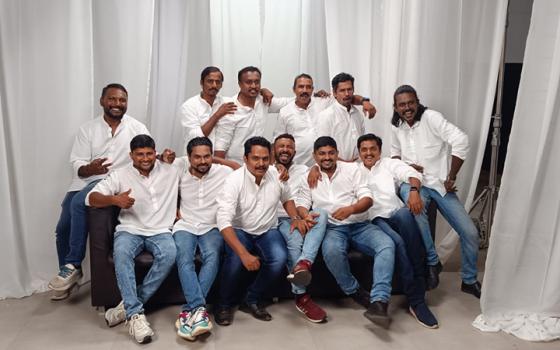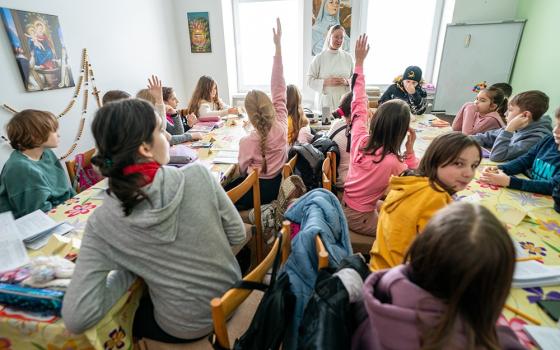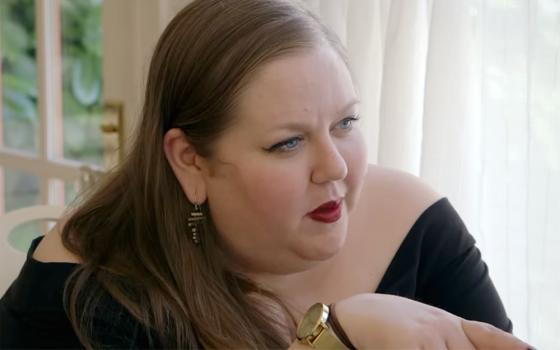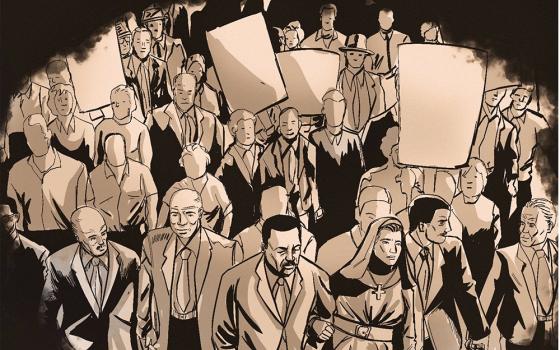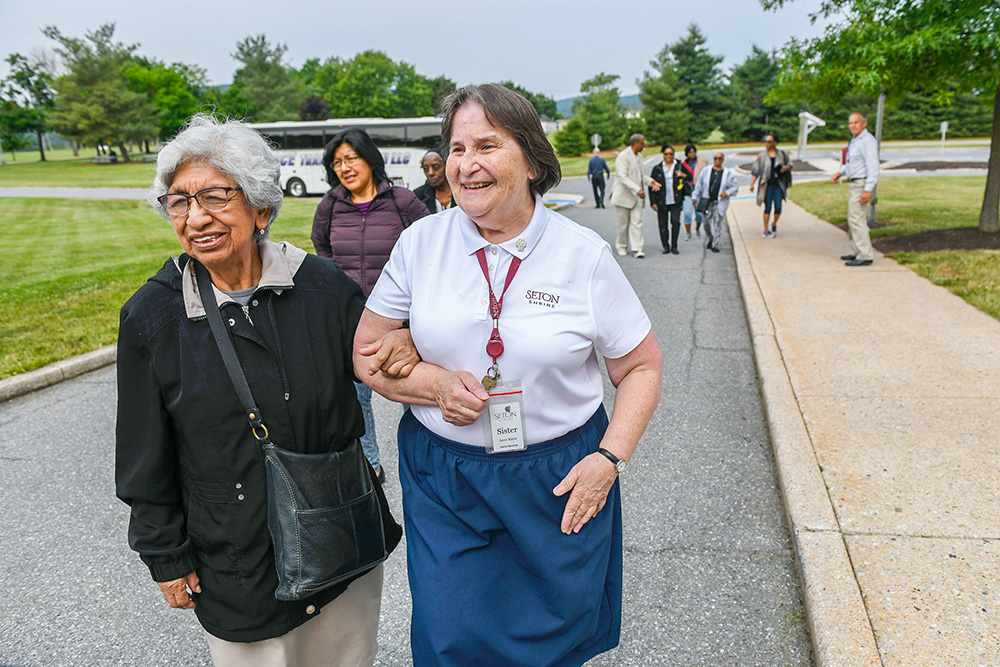
Daughter of Charity Sr. Anne Marie Lamoureux, right, welcomes guests at the National Shrine of St. Elizabeth Ann Seton in Emmitsburg, Maryland. A dream of Lamoureux’s grew into Seeds of Hope, a program that offers retreats to those marginalized by society. (Courtesy of the National Shrine of St. Elizabeth Ann Seton)
Daughter of Charity Sr. Anne Marie Lamoureux knows the restorative power of a retreat. A cancer survivor who for nearly 20 years worked in a community care center in New York's Bedford-Stuyvesant neighborhood of Brooklyn, she finds her annual retreat offers peace and a chance for "letting God talk to me."
A thought came to her when she heard a question posed at her congregation's provincial meeting regarding future outreach projects: If money were no object, what would your dream be? What if, she wondered, the people on society's margins — addicts, the homeless, the poor and isolated — could get to feel that same comfort in retreats designed for them?
Lamoureux saw her dream realized through Seeds of Hope, a program she helped create at the National Shrine of St. Elizabeth Ann Seton in Emmitsburg, Maryland, where she serves as a docent. Since 2018, Seeds of Hope has brought in hundreds of people from area 12-step programs, homeless shelters and impoverished rural areas for daylong retreats that include meals, meditation, fellowship and even time to tour the buildings and historic grounds where Seton, the first native-born American saint, and her congregation lived.
The program, which depends on a slew of donors, volunteers and details, is designed with retreatants' needs in mind. Costs are covered, and services like child care, audio-assisted devices for hard-of-hearing visitors, and transportation — from volunteer drivers to chartered buses — are provided.
'People should feel valuable. They should feel loved by God.'
Although Lamoureux stepped down as Seeds of Hope's facilitator at the beginning of this year, she's still part of the program, watching it grow. Between 2018 and 2022 — with COVID-19 limiting social gatherings — 17 retreats took place. Sarah Heil, hired last August as outreach programs coordinator, said the projected plan is to offer at least 12-15 retreats annually, with an eventual goal of about two retreats per month.
Each retreat makes sure its participants are offered truly personal attention, Lamoureux added.
"People should feel valuable," she said. "They should feel loved by God."
_____
GSR: What influenced this dream of yours that became Seeds of Hope?
Lamoureux: When I worked in pastoral care, I lived in Brooklyn, in Bed-Stuy. My immediate neighborhood was five blocks by nine blocks, and 95,000 people lived there. So, one block had about the same population as the entire town I'm in now.
The projects were 12-24 stories tall. Elevators didn't work all the time. Trash often wasn't picked up. You'd hear gunshots.
But I loved the people. No one put on airs, and they had great trust in God. The liturgies there were culturally rich and all-inclusive. But the people never got out of there and never got anything for themselves.
How did the program get started?
The community care center I was working in was bought by a for-profit, so, sadly, they didn't need any more pastoral care. I came to the national shrine thinking I would be here for one year. But I was diagnosed with cancer, and it turned out I needed three years of treatment, so I stayed in the area.
While on a sabbatical, I realized I missed having my boots on the ground and those cultural connections I'd formed in Bed-Stuy. I mentioned this to Rob Judge, the executive director of the shrine, and I shared my dream with him.
Advertisement
And he told me that Pope Francis had written Sanctuarium in Ecclesia on the role of shrines. And in that letter were so many things that matched the dream. The pope talks about how shrines "are still perceived as sacred spaces to which pilgrims go to find a moment of rest, silence and contemplation in today's often hectic life," and how "shrines can be a true refuge for rediscovering oneself."
And the last line we took to heart is that, in shrines, "the doors are wide open to the sick, the disabled, and above all, to the poor, the marginalized, refugees and migrants."
I talked with Rob in 2017 and was given the go-ahead. The first retreat was in April 2018. But Seeds of Hope is not just mine. It's not a one-person endeavor, it's a community.
It was the director saying, "OK, let's see what we can do." Then people said, "I always wanted to prepare food," so they prepared food for the retreats. We've got people knitting shawls for those who come.
The shrine's National Leadership Council, chaired by Luci Baines Johnson, raises funds and gets the message out. My younger sister sent me a check for my birthday, writing, "For your dream."
It's everybody. It's a joint effort to make sure the people who come here are surrounded by love.
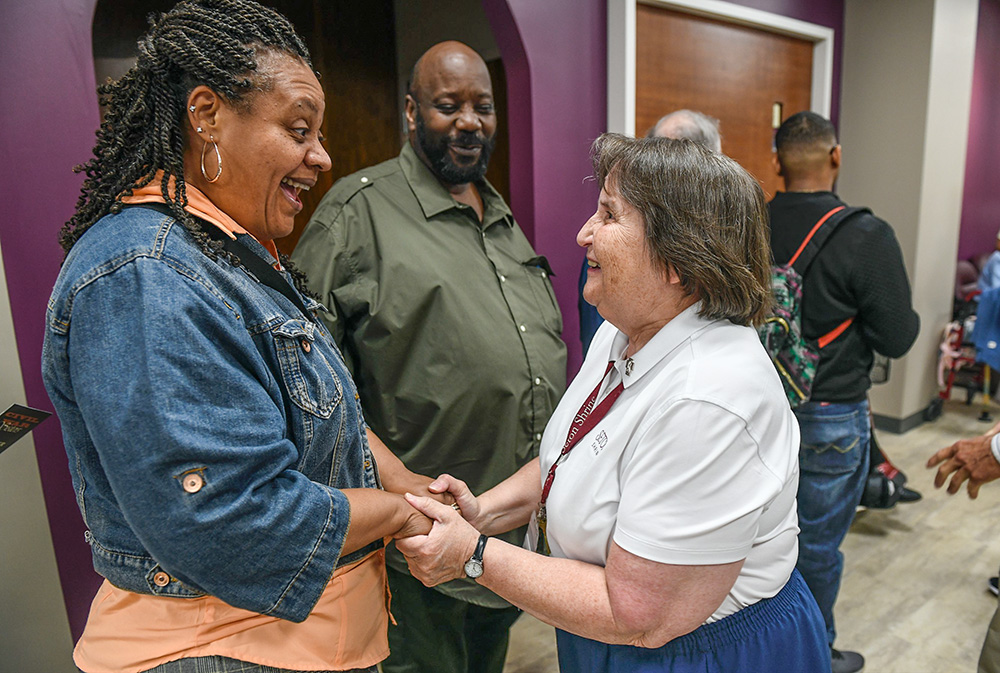
Daughter of Charity Sr. Anne Marie Lamoureux, right, has watched Seeds of Hope, a program that offers retreats to those marginalized by society, expand since it began in 2018. (Courtesy of the National Shrine of St. Elizabeth Ann Seton)
How do you find people for the retreats?
We're in the rural part of northern Frederick County in Maryland, just south of Gettysburg, Pennsylvania. Our sisters are at the Seton Center, which has social service programs. I told them we needed to know what the people in the area wanted, so the social workers and case managers pulled names from their files.
When people came, we had a meal for them, gave them a little stipend and other things, and asked them why they weren't coming here. Some have lived here forever but didn't know if they were welcome here because the place is so big. People loved it because many of them, as one sister said, didn't have any place where they could put their feet and where they felt they belonged.
Now, it's not so much social workers we turn to as our sisters working in different places. We're bringing people up from Baltimore and a very poor section of Washington, D.C.
Sometimes, it's been local groups that are just one step from being homeless. Some people don't have phones or any way to communicate, so you're out in the field finding them. Some are living under the radar. They don't want anybody to know where they are.
One of the people who came to the first local retreat had to leave early because he was in a lot of pain. I searched all over to find out where he was so I could bring him a meal, and finally located him in a place called The Rambler Motel. From then on, he told the other people, so they got to trust me, and I've been privileged to connect with them.
'I tell them we're not trying to convert them. We're trying to give them a place where they can be near God.'
What are the retreats typically like?
We try to make them feel welcome. I always go out to the bus and get on it, welcome them and tell them the day is for them. They can do the things we have planned for them or choose what they want. I tell them we're not trying to convert them. We're trying to give them a place where they can be near God.
We have breakfast for them. Then we go out on tour. We have the houses that Mother Seton lived in, where her mission first got started and what became the first free Catholic school for girls in the 1800s.
Then we have a nice meal for them and give them another meal to take home. We don't use paper plates or plastic silverware. We set up the tables with tablecloths and regular china and glasses. We try to respect people.
I did adult education in the inner city, and I know a lot of people don't know how to read, so I try to be sensitive to that, pick up on things and make them feel at home.
In the afternoon, I do meditation with them. They get really relaxed, and if they go to sleep, that's fine. We look at the artwork in the basilica. I tell them to take time for whatever feeds their spirits.
What impact have you seen on people who've attended Seeds of Hope?
Before one of our first local retreats, a friend said, "I have somebody in mind who would like this, but she's very fragile, and I don't know if she'll stay the whole time. I'll bring her and stay with her, and if she needs to leave early, I'll take her home."
So my friend came with this woman, and the woman stayed the whole time. When I visited her six months later, the woman told me she never went outside of her apartment but shared that she began walking down the street. She started to do things she hadn't been doing before. We see little miracles like that.
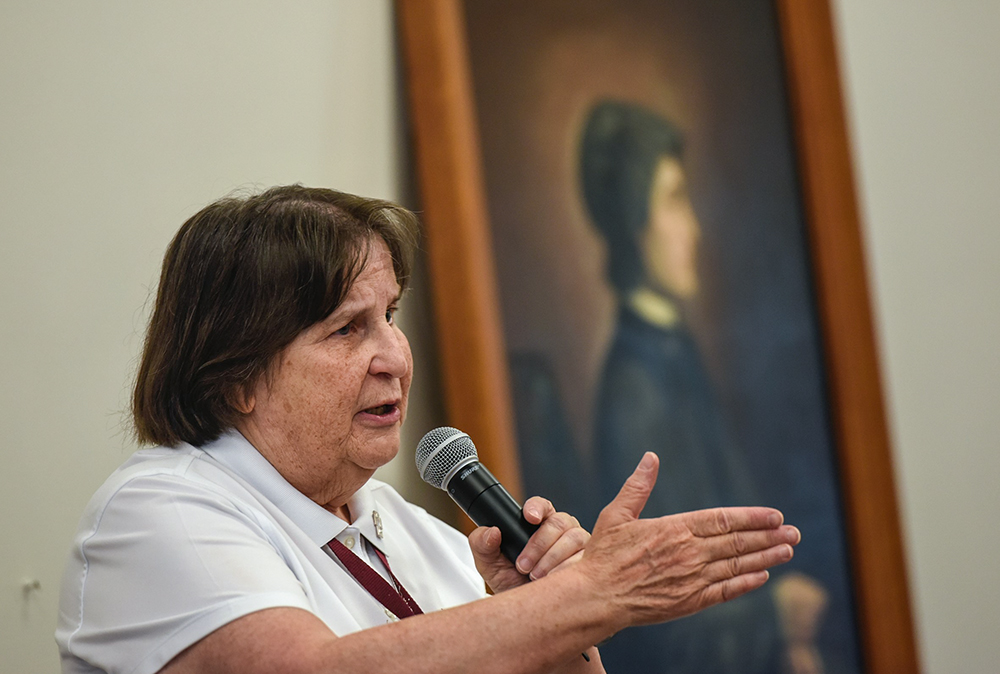
Daughter of Charity Sr. Anne Marie Lamoureux speaks at the National Shrine of St. Elizabeth Ann Seton in Emmitsburg, Maryland. (Courtesy of the National Shrine of St. Elizabeth Ann Seton)
Can one retreat make a difference in someone's life?
What we're trying to do, especially with the locals, is have them come back for other events, like a Christmas show or a concert or get them together for a meal. We always tell them they're part of the family. We want them to feel that this is their place whenever they want to come. We don't want to lose them.
We've found that people form a real community as they're here. And some of them try to keep in touch with each other. People feel connected.
I got a call from a police officer when a homeless man who had been at the retreats died. We had a funeral for him. He was totally under the radar. He'd had some health problems but wouldn't get help. We had a local doctor who saw him and ultimately wrote his death certificate.
How has your work in this program affected you?
At the end of a retreat, we ask people what touched their hearts the most from the day. Once, I remember three people out of a group of about 25 said they felt safe. You don't realize all the stress they're under trying to find their next meal or worrying if the baby gets sick. You don't always know what their problems are. Sometimes it's just trying to survive.
One of the things about Seeds of Hope is that you see people at their best as far as caring for others, not just caring but listening to each other. I'm amazed at how good people are. For me and all of us here, you get to see people as people.
In these times, we often just check people off. But we have so much to learn from each other.

